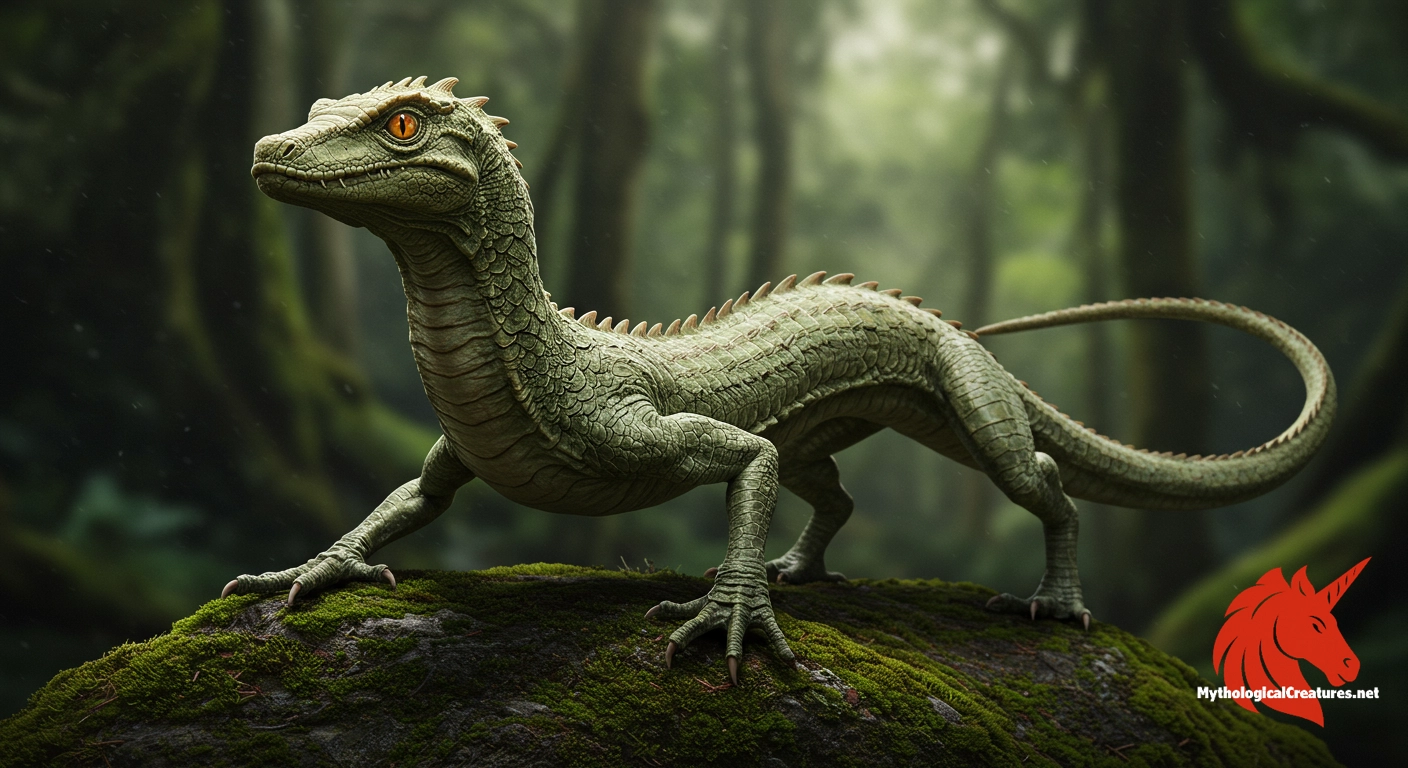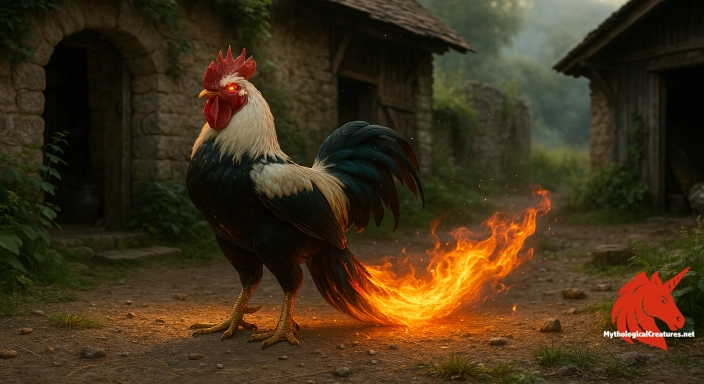Dilong: Dilong, or Earth Dragon, is a mythological creature from Chinese folklore known for its serpentine form and mystical attributes.

Dilong
Dilong - Dilong represents the intertwining of the natural world and mystical forces, embodying the creative power of the earth.
Origins & First Encounters
Dilong, the earth dragon, occupies a niche in Chinese myth that is both enigmatic and deeply symbolic. Its origins are intertwined with ancient cosmologies, where the interplay of the elements was paramount in shaping cosmic order. Emerging from cultural narratives that date back millennia, Dilong has been revered as a creature that bridges the power of the earth with the realm of the mystical. In early literary sources, dragons symbolised vital forces, and Dilong in particular was seen as an embodiment of the earth’s nurturing yet inscrutable nature. This mythic entity, tied intrinsically to the soil and fertility, reflects the broader Chinese emphasis on harmony between man and nature. Its name, literally meaning 'earth dragon,' also reveals a fascinating linguistic duality, as it lends itself to interpretations ranging from a celestial being to an ordinary creature like the earthworm in traditional medicinal contexts. Over time, the character of Dilong was adapted into various cultural narratives, each echoing the fundamental theme of nature's cycle and balance. Deep-seated in both rural traditions and sophisticated philosophical discourses, the earth dragon continues to be a symbol of grounding and renewal in Chinese cultural heritage.
Source Texts & Tale Variants
Ancient texts and folklore provide a tapestry of narratives in which Dilong plays a subtle yet significant role. While not as frequently celebrated as other celestial dragons, references to Dilong can be discerned in classical compilations of myth where dragons serve as metaphors for natural phenomena. Early lexicons and compendiums of Chinese characters, such as the Shuowen Jiezi, include entries that use the term in various contexts, hinting at its multifaceted significance. Daoist writings and agricultural manuals have intermittently portrayed the earth dragon as a spirit that governs the land’s vitality. Oral traditions, passed down through generations, have expanded on these early attestations by weaving local ritual practices and seasonal lore into its narrative. In several regions, stories recount the appearance of Dilong during times of environmental change or to mark the onset of agricultural cycles. Variations of the tale appear in folklore, with some traditions linking the creature to subterranean treasures and the healing energies of the earth. Despite the sparse direct mentions in the most renowned texts, these layered accounts highlight an enduring yet understated presence in Chinese mythological literature.
Form & Powers
The physical portrayal of Dilong is as evocative as its symbolic significance, blending elements of grandeur with the modesty of the earth. Often depicted as a sinuous, serpentine form, Dilong carries an elegance that belies its association with the terrestrial. Its body is imagined as elongated and flexible, with an undulating movement reminiscent of an earthworm, yet embellished with mythical scales that capture earthen hues such as deep russet, mossy green, and rich ochre. Some depictions enhance this imagery with subtle ridges along its back, evoking mountainous terrains or the rough textures of rich soil. The creature’s eyes are often described as luminous portals to ancient wisdom, suggesting a connection to the very soul of the earth. Occasional artistic renditions include modest horns or delicate filaments that blend seamlessly into its sleek form, reflecting a union of nature’s simplicity and complexity. The interplay between the visible and the hidden in its design mirrors the dual usage of the term in traditional medicine, where the humble earthworm is both a literal and symbolic healing agent. While not as flamboyant as the dragons of the heavens, Dilong’s appearance is intrinsically rooted in the organic, ever-changing qualities of the earth.
Regional Faces
Across the vast expanse of Chinese territory, the portrayal of Dilong assumes diverse forms that mirror the ecological and cultural variances of each region. In the northern highlands, where the rugged terrain imposes its own narrative, Dilong is often envisioned with robust, coarse scales that echo the rough, enduring landscape. Southern traditions, in contrast, tend to depict the earth dragon in a more fluid, graceful manner, with sleek lines that evoke the gentle curves of riverbanks and rice paddies. In rural communities, local legends often imbue Dilong with a benevolent character, celebrating it as both a guardian of farmlands and a harbinger of seasonal prosperity. Some Daoist temples in the countryside incorporate motifs of the Dilong into their decorative arts, subtly integrating local natural elements such as jade or clay figures. Urban legends, too, have adapted the motif, occasionally presenting the creature in modern artistic interpretations and community festivals. The evolution of its image from a solemn earth guardian to a more playful cultural symbol signifies the adaptability of myth as it interacts with local environments. These regional adaptations underscore the multiplicity of narratives that have converged to form a richer, more nuanced portrait of Dilong.
Cultural Parallels
An intriguing aspect of Dilong lies in its cultural parallels with other mythic creatures, both within and beyond Chinese borders. Much like the serpentine entities found in European and Native American folklore, this earthly dragon embodies the mystique of subterranean power and the regenerative force of nature. In Western traditions, creatures such as the earth wyrm or hidden dragons in rural legends share a kindred spirit with Dilong, both symbolising the fertile and dangerous aspects of the natural world. Japanese interpretations of dragons (ryū) also display regional nuances, though Dilong’s distinct affiliation with the earth sets it apart from its often water-associated counterparts in East Asia. Comparisons can be drawn with the Mesoamerican concept of the feathered serpent, where dual symbolism bridges the animate and inanimate aspects of nature. Each of these cross-cultural figures echoes a central theme: the reverence of the natural world and the acknowledgement of forces that sustain life. While the stylistic depictions and narrative contexts differ, the underlying motif of a creature that is at once mysterious and life-giving is remarkably consistent. This comparative lens highlights not only the universality of earthly symbols across mythologies but also the unique nuances that the Dilong brings to the broader tapestry of global dragon lore.
Legacy & Modern Evolution
The historical evolution of Dilong mirrors the broader shifts in Chinese cultural and philosophical outlooks over the centuries. Initially emerging as a modest but potent embodiment of the earth’s pulse, the earth dragon has gradually transformed in the collective imagination to represent resilience and natural harmony. In classical art and literature, depictions of Dilong were carefully interwoven with agricultural symbolism, often emphasising its connection to the rhythms of planting and harvest. During the Ming and Qing dynasties, while more flamboyant celestial dragons dominated imperial iconography, the subdued image of Dilong gradually came to denote the fundamental forces of nature that underpin human existence. In modern times, this myth has been revitalised in literature, cinema, and digital art, where contemporary creators reimagine Dilong as a symbol of environmental consciousness and the urgent need to preserve our natural world. The dual meaning of Dilong—linking it to both legendary might and the humble earthworm—has also inspired novel interpretations within traditional medicine and holistic healing practices. As ecological concerns have taken centre stage in modern discourse, the earth dragon’s symbolism of renewal and balanced energy has resonated strongly with audiences worldwide. Today, the legacy of Dilong endures as a testament to the enduring power of myth to adapt and inspire across generations, merging the ancient with the modern in a dialogue about nature and human identity.
Interesting Fact
An intriguing aspect of Dilong is its dual usage in language, serving both as the name for a revered mythological dragon and as a term for earthworms in traditional Chinese medicine, highlighting a unique interplay between myth and natural science.
Quick Creature Info
Associations:
Our Mythic Legendary Rating:

Also Sometimes Known As:
Habitat:
Supernatural Powers:
Physical Attributes:
Abilities:
Behavior:
Lore:
References
Discover Another Mythical Legend You May Not Have Heard Of?
Uncover the mysteries of ancient folklore and expand your knowledge of legendary beings from cultures around the world.
Dare to Meet the Aitvaras....
Mythical Disclaimer: The images and data on this site are derived from various historical and literary sources, but we have found that many myths often have multiple versions and interpretations across references, sometimes contradictory. As a result, these creature depictions are artistic interpretations—imaginative blends of folklore, legend, and a dash of AI guesswork. Because creature descriptions vary widely, our illustrations and accompanying information represent our best effort to honor mythology while bridging creative gaps. Enjoy these interpretations—just remember, we've done our best to respect the stories and validate available data, but in the realm of mythology, details often shift, imagination leads the way, and nothing is ever set in stone!
Curated by the Mythological Creatures Team (rev. May 2025)
